Serene Way Sidewalk Project
Snohomish County, Washington
Source: Pedestrian and Bicycle Information Center (PBIC)
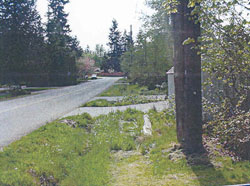
Before
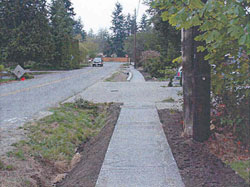
After
Problem
Prior to this sidewalk project, walkers in the Lake Serene community were forced to walk in the travel lanes of Serene Way, a two-lane local access road. Walkers sometimes had to jump into the ditches to avoid oncoming cars along curves.
Background
The Lake Serene Community Association initiated this project when they requested a walkway along the road. The road had minimal shoulders, and drainage from the road collected into open ditches along both sides of the road. Existing right-of-way for the road was 60 ft.
Solution
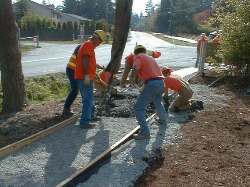
Serene Way during the installation of the new sidewalks. Source: Snohomish Department of Public Works.
The project operated on four main objectives: 1) to provide a walkway separated from the roadway, 2) to work with the association, 3) to minimize impacts to adjacent properties, and 4) to minimize modifications to the existing drainage system and avoid the use of a detention pond/pipe design.
The 4,500 linear ft walkway provided safer passage not only for pedestrians, but now also for bicyclists, wheelchair users, and those who need to push baby strollers. The walkway is located behind the drainage ditches, which provides a buffer between cars and pedestrians. Additionally, the sidewalk connects with adjacent pedestrian facilities and provides a safer route to school for students of a local elementary school.
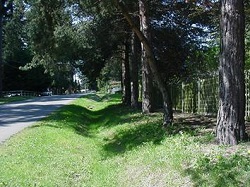
Serene Way before sidewalk installation. Source: Snohomish Department of Public Works.
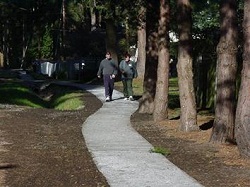
Pedestrians enjoy the new Serene Way sidewalks. Source: Snohomish Department of Public Works.
The Community Association met together with the Public Works Department a total of five times. At the first meeting, project options were presented with costs ranging from $200,000 to $500,000. After the association realized the limited available funding for the project, they volunteered to reduce costs by removing or relocating any landscaping, vegetation or fencing that would be in the path of the walkway. The Association discussed schedules and the pros and cons of using porous concrete at subsequent meetings. A certificate dedicating the walkway was eventually presented to the Association.
In order to minimize the impact on adjacent properties, an alignment within the existing right-of-way was chosen that would meander among existing project site features such as fences, trees and utility poles.
Drainage was challenging for the project due to lack of funding, the location near the lake, and the dense residential surroundings. The standard pipe, catch basin, and detention pond/pipe design was infeasible. It was decided to use porous concrete instead, which acts as an infiltration and retention area, mimicking natural soils filtration throughout the pavement depth. An exemption from detention was granted from the drainage compliance officer.
Though the project budget was estimated at $225,000, final costs totaled $294,000. The project was completed in 10 months.
Results
There is anecdotal evidence of increased foot traffic since the installation of the walkway, during the nighttime. The use of porous concrete material enabled the walkway to be built, eliminating the need for a detention system and its associated design, right-of-way, and construction cost, which would have totaled $500,000.
Contact
Max T. Phan, P.E.
Project Manager, Snohomish County Public Works
2930 Wetmore Ave. Suite 101
Everitt, WA 98201
(425) 388-3109
mphan@co.snohomish.wa.us
Images Source
Institute of Transportation Engineers Pedestrian Project Award Application. Snohomish County Public Works. http://www.ite.org/awards/pedproject/Snohomish.pdf




